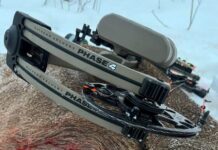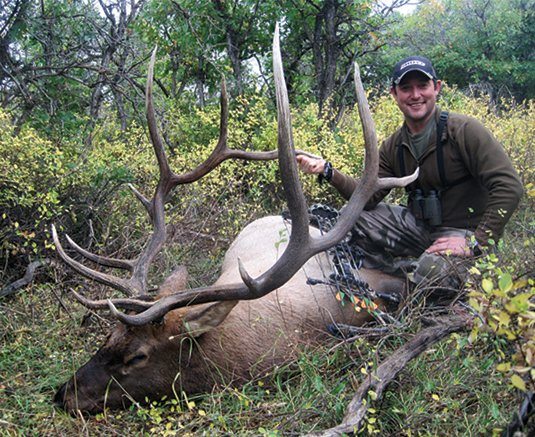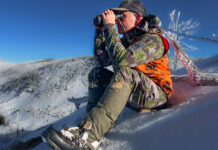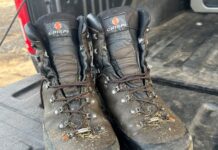Blister Prevention
Stephen Lathrop of Lathrop & Sons Boots

Of all things we prepare to encounter on a hunt—such as harsh terrain, altitude, and foul weather—the most detrimental may well be the smallest and most easily overlooked. A blister is a collection of fluid beneath the epidermis (first layer of skin). Unlike calluses, which are caused by prolonged rubbing, a blister most often occurs due to a period of intense friction on a localized area. A blister on the foot, or even worse, several blisters can incapacitate even the most determined and toughest of us all. Fortunately, there are preventative measures that can be taken that greatly reduce the chances of onset and, if they do occur, the effects of blisters.
Proper Fit
Many factors can play a role in causing blisters on the foot. For us as hunters, footgear and all of their components are the determining factor. An improper fitting pair of boots can very well lead to blistering. A pair of boots that are too small will create pressure points, such as at the ball and also the toes, which will ultimately result in the formation of a blister. Conversely, a pair of boots that are too big will result in excessive movement within the boot eventually causing “hot spots” at areas like the back of the heel or medial (inside) and lateral (outside) sides of the foot.
To be sure you are wearing correctly fitted boots, wear them around the house for a while to determine proper fit. If possible, climb a flight of stairs several times. Also, do not forget to check for adequate length. To do this stand with your heels on an edge of a step like you are down-hilling. This will cause your toes to slide slightly forward, if your toes touch the end of the boot re-lace them and try again. If contact still occurs your boots are too short. Once proper fit has been established get out and put some miles on them. While breaking in the boots you can determine if any problematic areas exist. We offer additional modification for those of you who feel that the boots fit well but an area exists that merits special attention.
Support and Control
Beyond fit, be sure to use a boot that offers the necessary amount of support and control. A lack of control will result from boots that have a flexible mid-sole and upper. By subjecting your feet to excessive motion you will in time create an area—whether it be the toes, sole, or heel—that has a penchant for blistering. This issue can be easily avoided by insuring that the soles of the boots are stiff enough that they cannot be twisted by hand.
A lack of support is equally harmful. When traversing rough, a non-supportive upper will allow your ankles to roll or twist and the lateral sides of your feet to rub against the lining in your boot. This is especially the case for the foot on the downhill side when side-hilling. Depending on the hunt, it may be necessary to purchase a ten-inch tall boot for added support. The type of boots that fit the necessary criteria described above are best described as technical. Fitting this type of boot is very technical as well. The reason for this is due to the rigidity of both the mid-sole and upper, both of which must work (fit) simultaneously with the function of the foot. This becomes especially important for fitting feet with deformities.
Foot Deformities
Chances are that some of you reading this will have one or more of the following foot deformities, all of which increase your feet’s proclivity for blistering. Hammertoes are a fairly common occurrence that often cause blisters to form where the constricted toes contact the toe-box. Bunions also create pressure where the protrusion and the lining of the boot meet. Another deformity, Haglund’s Deformity, is a noticeable bump at the back of the heel that’s penchant for blistering is well known to those who have one. Although not a deformity, a high volume foot may also tend to blister due to the difficulty of finding a boot that offers enough space to prevent pressure points. Once again the opposite is true for those with very low volume feet who have trouble controlling excessive motion within a boot. For all of the aforementioned maladies we have methods and solutions that may allow a comfortable fit for those who have always struggled to achieve one.
Aftermarket Footbeds
The rise in popularity of aftermarket inserts has also created a blistering issue. When fitted properly, footbeds can aid with control, support, and blister prevention. At Lathrop & Sons, we have combined our 48 years of biomechanical experience with Extreme Tool, an award-winning supplier of mold design, engineering, and manufacturing services to develop the Lathrop & Sons’ High Country Footbed.
The High Country Footbed can be utilized in all mountaineering footwear, such as Cabela’s Meindl, Lowa, and Kenetrek boots. Unfortunately, there are many inserts on the market today that are causing more blisters than they are preventing. The main cause of this is more often than not improper fitting of the boot and insert to the foot. The average aftermarket insert is a 1/8″ to 3/16″ thicker than the standard inserts inside of boots. This essentially creates less volume inside the boot, which may cause contact of the arch of the foot with the tongue/gusset and the tops of toes with the toe-box. We do recommend aftermarket inserts for all boots but we urge you to let a professional fit them so that all benefits can be attained.
The Logistics of Prevention
“An ounce of prevention is worth a pound of cure.” We’ve all heard this before and the problem of blistering is no different. There are many preventative measures that can combat the onset of blisters. Proper footgear, fit, and choice have already been mentioned, but there are other relatively simple methods that will help you.
Anti-perspirant sticks or powders applied to the feet will reduce moisture build-up and friction thus helping to prevent blisters. Choosing proper socks that are constructed with non-abrasive material, like silk and merino wool will also help. Applying duct tape or mole’s skin to areas that you have found to be prone to blisters is also a smart step. For the best protection we have assembled the Lathrop & Sons Foot Aid Kit, which contains several products that we use that have been recognized in the Podiatric field to eliminate friction. We feel that our hunting endeavors are important enough to merit the same concern. Having said that, there is no way to guarantee that a blister will not occur at anytime, so we reiterate; an ounce of prevention is worth a pound of cure. Pack along your pound of cure in the form of duct tape, mole’s skin, or our Foot Aid Kit.
For most of us, a Western big game hunt is the culmination of playing the state tag lotteries, months of preparation, and more than a couple of hard-earned dollars. We think the experience should be physically demanding, as that is part of the mystique, but not necessarily painful. A severe blister can hinder you to the point of not being able to perform at your best and can cost you the opportunity at the animal you deserve. We hope that you can take these tips and advice to make your next adventure even more enjoyable.























